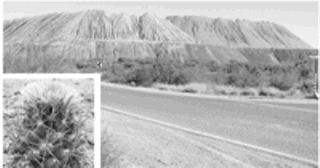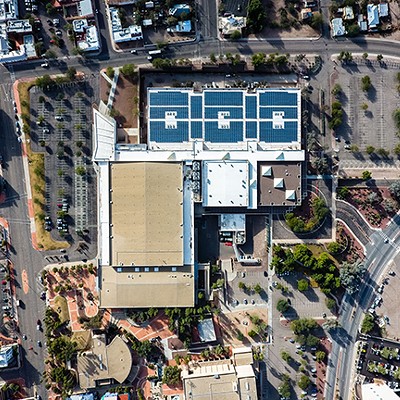The Sahuarita Road exit off Interstate 19 is where it begins. To the left is a new commercial development for the town that still hangs on to its agricultural roots with the pecan groves further east. Also nearby is the subdivision named Rancho Sahuarita, which will help make the town into a bedroom community.
Turn right at the exit, and the mining industry is right there, along with several housing developments sitting in the shadow of active mining tailings. The mining refuse continues, along with ranch houses here and there.
At the intersection of Helmet Peak and Mission roads, however, is the biggie: a 15,000-home subdivision is proposed on 4,000 acres here that, if approved, will put as many as 24 homes per acre in the middle of what is now mostly untouched desert.
It's one of the biggest development proposals to hit Pima County in 20 years, and critics worry the plan will be approved by the Pima County Planning and Zoning Commission on Oct. 31. If so, it could compromise the county's current conservation guidelines and put into action planning that will cause years of regret.
When Rebecca Roberts looks across the driveway of her Curly Horn Ranch home, she sees the 4,000-acre stretch as the home to the rabbits, quail, coyotes, Gila monsters and tarantulas, animals that also wander through her neighborhood and live in her yard.
Some 23 years ago, Roberts built her home there after living in Tucson. Back then, the Pima County building codes kept density at about four acres per home. To Roberts, that seemed just right then, and it seems just right now.
Roberts said she recognizes that some may question her desire to stop the Mission Peaks development, since she herself built a home in the middle of the desert. It wasn't until she settled in the home, she said, that she grew to appreciate the need to protect the area.
"I grew to understand it's logical to stay in the valley and not take over more desert," Roberts said.
The Curly Horn neighborhood is not a retirement community, according to Roberts, although most of her neighbors are seniors who live in the area year-round and are often on fixed incomes. Roberts said she has asked all of them to mail comments against the proposal to the county.
"They may not understand what this could mean for our area," she said. "They may not realize their voices need to be heard."
The Mission Peaks property, owned by Henderson, Nev.-based American Nevada and Ruby Star Ranch, sits north of the Phelps-Dodge Sierrita mine complex and west of the Twin Buttes mine complex.
Two years ago, Roberts mailed a similar letter to her neighbors when American Nevada first proposed zoning amendments to the town of Sahuarita to accommodate the development and annex the area. But unbeknownst to Roberts and her neighbors, American Nevada decided to negotiate the zoning amendments needed for the development with Pima County instead after it didn't look like Sahuarita officials and residents would approve.
"I thought it died out, but here it comes again," Roberts said.
In late 2006, American Nevada began negotiating with Pima County on two amendment proposals and conservation mitigation required by the county. If the two proposed zoning amendments are approved on Oct. 31, and are then approved by the Pima County Board of Supervisors, the view from Roberts' driveway will change drastically.
"Right now, we coexist (with the wildlife), but when you put in this development as it is proposed, you take away their home. They die out. The area is changed forever. We'll never get it back. I'm very much against it," Roberts said.
Roberts said she isn't against development or seeing another subdivision created in her neighborhood. It's the size of the project and a slew of unanswered questions that worry her--and worry neighbors and town officials from Sahuarita.
In the Curly Horn area, which consists mostly of manufactured homes, Roberts is on a well that had to be drilled 500 feet to get to water; most of her neighbors have water trucked in from Helmet Peak Resources.
When an American Nevada representative first talked to area residents two years ago, Roberts said, they never got a straight answer on water.
"It was mostly double talk. I don't know if much has changed since then. Regardless of where they get it, it's going to take it away from some place else," Roberts said.
The first major plan amendment submitted by American Nevada asks the county to change much of the area's zoning from its current designation of low-intensity rural to medium-intensity urban. The changes would allow American Nevada to build from one to 24 homes per acre.
The second amendment focuses on a 632-acre parcel currently owned by the State Land Trust. The land isn't currently up for auction, but American Nevada's proposed amendment would allow American Nevada to develop several roads leading to the land that would eventually make the property better-suited for development--and more likely to go to auction sooner. The development company's plan includes additional housing, at one to 24 homes per acre, to be included on this parcel, too.
Critics of the proposal include Carolyn Campbell, executive director of the Coalition for Sonoran Desert Protection. Yes, one of the red flags is the fact it is one of the biggest development proposals to go through Pima County in a while, but Campbell said what concerns her most is the lack of attention paid to the county's development guidelines in the Sonoran Desert Conservation Plan, especially those that require off-site conservation, depending on the size of a development.
Campbell pointed out discrepancies in conservation planning regarding the project. In a July 24, 2006, letter from Pima County to Sahuarita (when the town was considering the project), the county commented that Mission Peaks was out of character with the surrounding area, and on-site conservation of more than 3,500 acres was needed.
Because the Mission Peaks area is home to the endangered Pima pineapple cactus and has a large number of identified riparian areas, Campbell was surprised to see the county change its tune when it began its own talks with American Nevada. The end result is a proposal that the company pay the county $13 million for off-site conservation that will purchase about 2,000 acres of open space property--not the 3,500 acres first suggested by the county to Sahuarita. If it was 3,500 acres, Campbell said, the off-site conservation costs would be more like $50 million for American Nevada.
Campbell said she is concerned about how past and future developers may look at the Mission Peaks proposal. Past development companies have worked hard to work within the guidelines of the Sonoran Desert Protection Plan, while American Nevada representatives have told her, she claimed, that they are not interested in following the guidelines. Ultimately, Campbell said this proposal may weaken the Sonoran Desert Conservation Plan and negotiations with future developers.
There is also the circuitous route the plan has taken since it was first submitted to the town of Sahuarita more than two years ago. Back then, the town was asked to look at the amendments and consider annexing the property. John Neunuebel, Sahuarita's planning director, said when concerns were raised, the plan was dropped before it went to a public hearing.
The town of Sahuarita officials officially weighed in with comments to Pima County regarding the recent proposal in a letter dated Sept. 27, 2007, from Neunuebel. The letter questions the county's proposal to allow American Nevada to pay the $13 million for 2,000 acres of conservation land located away from the development area. The county has identified the Altar Valley as one area where the 2,000 acres may be purchased--an area not near the current development. This is odd, considering that there are 15,000 acres of property in the vicinity of Mission Peaks that could be purchased to protect open space.
"The provision of open space in a location outside the Sahuarita/Green Valley area would be of no direct benefit to local residents who would incur the loss of open space resulting from additional urban development," Neunuebel wrote.
According to Neunuebel, the development is also a departure from the area's current development pattern that encourages growth along Interstate 19. If approved, the development would place stress on public transportation, roads and services.
Then, of course, there is water. Neunuebel said he has heard American Nevada is working to hook into existing water systems, such as the system used by the Rancho Sahuarita subdivision. The neighborhood has a 100-year water-supply certificate, but if it brings American Nevada onboard, it would have to apply for a new certificate through the Arizona Department of Water to show it can provide water for 15,000 additional homes.
Representatives from American Nevada and Rancho Sahuarita, as well Pima County administrator Chuck Huckleberry, did not return calls as of press time.
The Oct. 31 public hearing takes place at 9 a.m. in the Basement Meeting Room C of the County-City Public Works Building, 201 N. Stone Ave. For more information, call the planning department at 740-6800.














